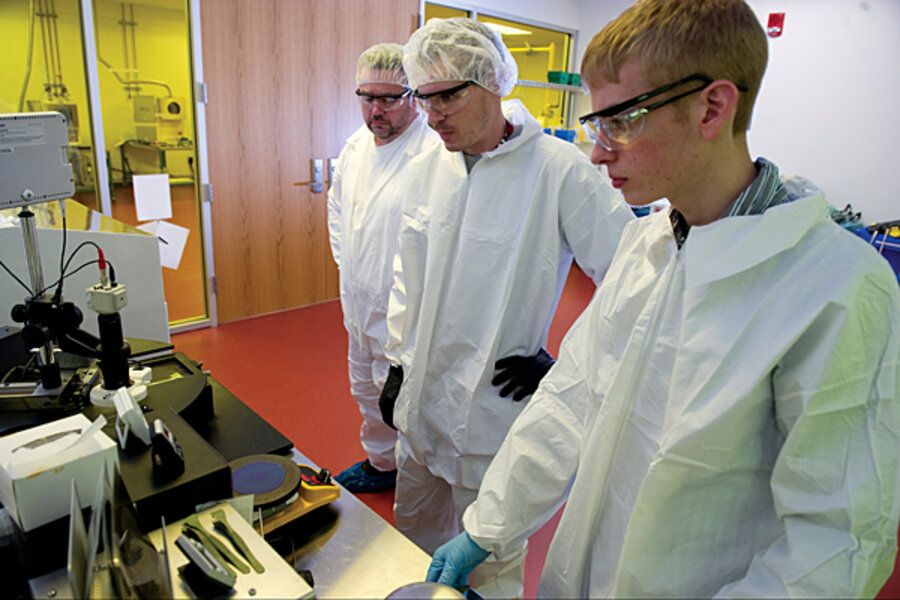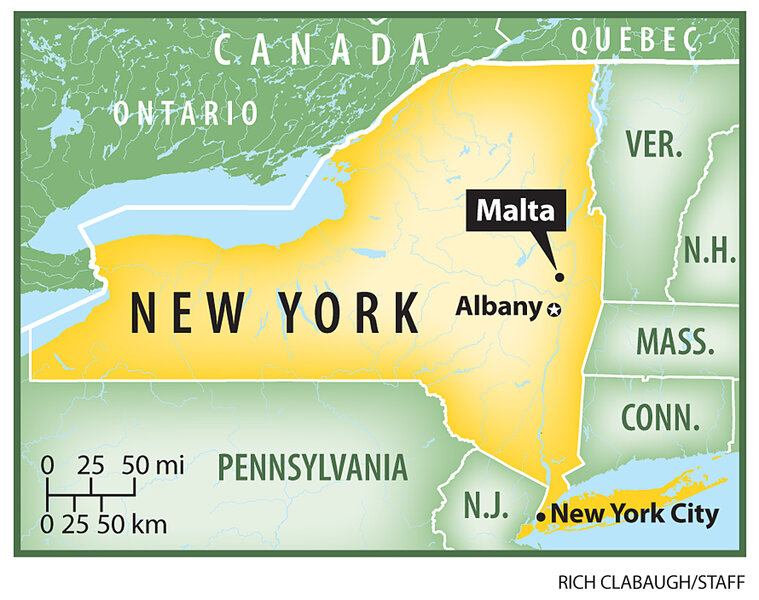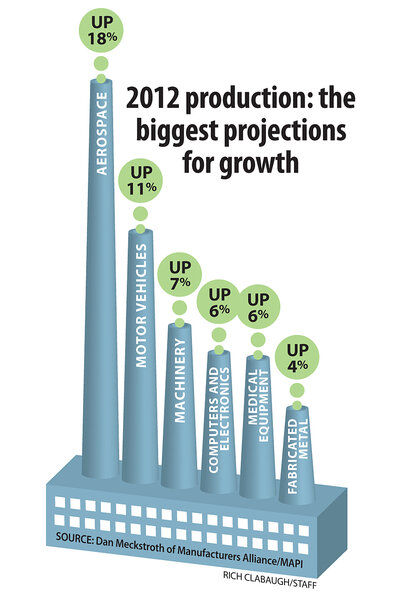Can American manufacturing really be cornerstone of economic revival?
Loading...
| Malta, N.Y.
In this small upstate community, a company called GlobalFoundries is ramping up to produce silicon chips for IBM and other customers.
The new plant, which is about the size of six football fields, has hired 1,100 workers in the past two years and plans on adding another 300 this year. Construction workers are still bustling around the $4 billion facility, which has expanded before it's even shipped a silicon wafer – and will eventually be a $7 billion operation.
The company is attracting the attention of high-tech companies around the globe. And because the company is more dependent on PhDs than on manual labor, it is an example of where the United States has an advantage over places such as China, where labor costs are so low.
The optimism surrounding the plant is emblematic of a change that is taking place from Charleston, S.C., to Detroit: America's manufacturing sector – particularly what is termed "advanced" manufacturing such as that at GlobalFoundries – is starting to come alive.
President Obama has made support of US manufacturing an important part of his plan to further an economic rebound. He promoted the sector in his State of the Union message in late January.
True, some commentators continue to question whether American manufacturing can compete in the global economy, especially when so many US jobs have moved offshore. But some policymakers see progress.
"We are the most competitive in manufacturing that we have been for the past two or three decades," said Gene Sperling, director of the National Economic Council, in a session with reporters last month.
A rebound in manufacturing has important ramifications for the US economy. Sixty percent of exports relates to manufacturing, 90 percent of patents, and 70 percent of private-sector research and development. Moreover, as can be seen around Malta, N.Y., the opening of a large manufacturing plant has a big ripple effect in a community: Builders erect new housing, more restaurants open, and more tax dollars come in that can be spent on providing services.
"We do believe manufacturing punches above its weight economically," said Mr. Sperling.
The actual number of new jobs in manufacturing is relatively modest, in part because US productivity is so high. Last year, according to the Bureau of Labor Statistics, the economy added about 330,000 manufacturing-based jobs. By way of contrast, some 2.3 million manufacturing jobs were lost in the recession, which officially ended in June 2009.
"Of the 2.3 million jobs lost, not more than half will ever come back," says Dan Meckstroth, chief economist at Manufacturers Alliance for Productivity and Innovation (MAPI) in Arlington, Va. "We may get 1 million more back."
Nonetheless, the Obama administration is indeed making manufacturing an important part of its economic strategy for 2012, and possibly beyond. It is asking Congress to remove from the tax code the deduction for moving expenses when a company transfers jobs overseas. At the same time, it's proposing an expansion of the deduction for manufacturing and a doubling of the deduction for advanced manufacturing technologies – from 9 percent to 18 percent.
The administration is also proposing a new "manufacturing communities tax credit," which would provide $2 billion per year in incentives for three years to companies that build in a community that has suffered a major job-loss event, such as a plant closing.
Mr. Obama covered these points at a Jan. 25 rally at Conveyor Engineering and Manufacturing, a growing manufacturer of giant augers in Cedar Rapids, Iowa. "We've got to stop rewarding businesses that ship jobs overseas [and] reward companies like Conveyor that are doing business right here in the United States of America," Obama said.
Even if Congress does nothing, economists expect to see some manufacturing jobs return. For example, the auto industry is expanding production as consumers, driving old models, start to replace their clunkers.
On Jan. 6, Chrysler announced it will add 1,100 jobs at its Jefferson North plant in Detroit, where it makes the Dodge Durango and the Jeep Grand Cherokee. On Jan. 13, BMW announced it would add 300 jobs at its Greer, S.C., plant, and on Jan. 12, Daimler said it would add 1,100 jobs at its truck plant in Cleveland, N.C.
US manufacturers are also benefiting from a 23 percent decline in the value of the US dollar since 2002. The lower value makes US exports more competitive and imports more expensive. "This will be a tail wind for US manufacturers for quite some time," says Mark Zandi, chief economist at Moody's Analytics in West Chester, Pa.
Organized labor says it's pleased to finally see a pickup in manufacturing jobs. But as Robert Baugh, executive director of the AFL-CIO Industrial Union Council, observes, the US lost 6 million manufacturing jobs between 2000 and 2011.
"Most is internal, people going back to work," he says. "We have no illusions about how deeply the nation has been affected."
In fact, there is no question that manufacturing job losses are still taking place. Mr. Meckstroth points to food, beverages, apparel, paper, chemicals, and plastics as industries that are still shrinking. Some consumer-oriented businesses are also struggling, as are those in the housing market.
In fact on Feb. 7, a study by the US Business and Industry Council, which argues the Chinese use unfair practices, found that the share held by China of American markets for advanced manufacturing products grew by 16 percent in 2009 and 19 percent in 2010, and now stands at 7.5 percent in absolute terms.
"Dozens of America’s high value industrial crown jewels are steadily becoming just as vulnerable to Chinese competition as clothing, shoes, and toys,” wrote Alan Tonelson, the author of the study.
But it's apparent the tide has turned in other industries and in some places. In part, that's because of a new paradigm: States and cities are beginning to use their community colleges as an asset as they try to attract business.
For example, in Charlotte, N.C., Central Piedmont Community College (CPCC) views itself as the training division for companies looking to hire workers, says Tony Zeiss, president of the school. It has started an apprenticeship program modeled after those in Europe, says Dr. Zeiss.
One beneficiary of this is Siemens Energy, which builds gas turbines and uses CPCC to screen potential employees by measuring such things as math skills and the ability to read blueprints.
"They ask us what we need, and they custom-design training for that need," says Mark Pringle, director of operations at the company, which plans to add 300 to 400 workers over the next four years. "They [CPCC] make sure the trainees have mastered all the basic skills before we talk to them."
Another tack that some manufacturing companies are taking is to get training commitments from state and local governments before a factory is built. That was the case in Charleston, S.C., where the state agreed to spend $45 million to train people to work on Boeing's new 787 Dreamliner production line. That will ultimately result in 3,800 jobs.
"Many may be unemployed, and some may be underemployed," says David Ginn, chief executive officer of the Charleston Regional Development Alliance. "They are willing to go on their own time through a pre-employment training program, even though there is no guarantee the company will select them. It allows the company to see if they show up on time, they have the right attitude and work ethic, and they can do a specific task."
For many displaced workers, all they want is that foot in the door. For example, in Malta, Alexander Nieminski, a US Navy veteran who has been unemployed for a long time, is enrolled in the Hudson Valley Community College to get a degree in semiconductor manufacturing technology. One day in January, he and other students were in a mock "clean room," similar to what they would expect to find at GlobalFoundries.
"No one has guaranteed me anything," he says while decked out in white clean-room garb from head to toe. "But there are jobs in the region."
Since the late 1980s, New York State had wanted to attract high-tech companies to the region, including to Malta, which has a high density of colleges and universities and lots of water and electric power – but not many jobs. "We needed something. We had been having a brain drain for years," says Jim Angus, vice president of the Saratoga Economic Development Corp. (SEDC).
By 2000, the state decided to try to lure a high-tech manufacturing company to a large parcel of land in Malta, which had been secretly used by the US government in the 1950s to test rockets. State and local spending ratcheted up to $300 million to add water, sewers, and roads.
"The biggest risk is we never knew if this project would go south," recalls Tom Longe, chairman of SEDC.
By 2009, a new joint venture – GlobalFoundries – had made a commitment to build a plant, which is its first in the US. The company reasoned that the nearby community college could help provide workers with some of the skills it needed, and nearby universities such as Rensselaer Polytechnic Institute and the University at Albany could help supply some of the higher-level talent. In addition, the plant would be closer to IBM, a potential customer for its products.
"A lot of potential clients also like the fact we are in the US, which has stronger laws on protecting intellectual property," says Travis Bullard, a spokesman for GlobalFoundries.
The company figured that building the plant in the US would normally cost about $1 billion more than in other places such as Asia because of long-term issues such as taxes, says Mr. Bullard. But New York State wanted the factory so much that it was willing to invest $1.2 billion – partly in the form of tax credits and refunds. "The state of New York was very aggressive at recruiting us," Bullard says.
One reason that New York was happy to get the manufacturing plant: the multiplier effect. For every job inside the plant, Bullard estimates, there are four to five support jobs outside, such as workers who take care of the clean-room clothing. Also popping up are maybe an additional five to six indirect jobs, such as openings in new restaurants. Many of those workers need apartments, grocery stores, and day-care centers. Toward that end, downtown Malta now has construction crews everywhere.
"The office space is being leased out even before the buildings are finished," Bullard says.
Even more important, many residents have decided it's not necessary to move to Texas or other places in search of jobs. That's the case for Joe Palladino, who started work six months ago in GlobalFoundries' "ultrapure" water department.
"I'm very excited to be in a new industry: It's kind of like entering the auto industry in the 1920s," says Mr. Palladino, who has three children ages 12 to 16. "Being close to home is real convenient, and it looks like a long-term job that someone my age would love."









